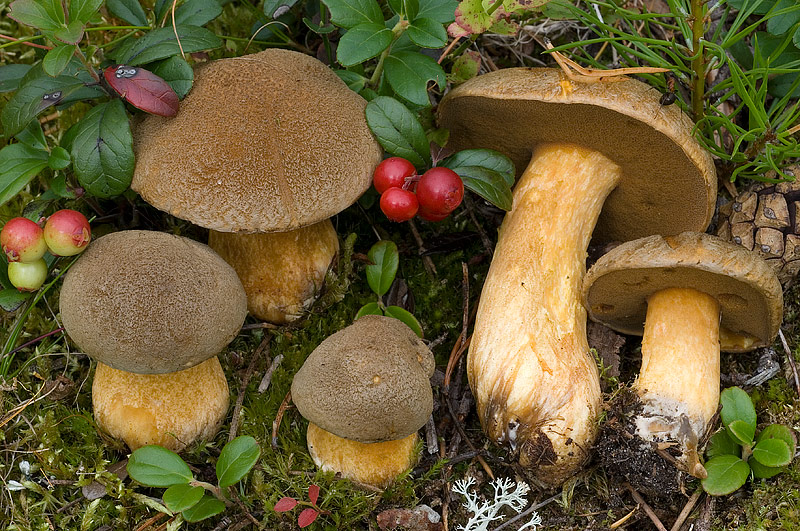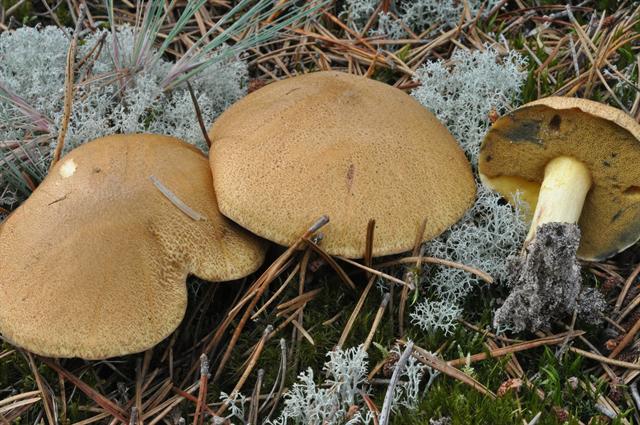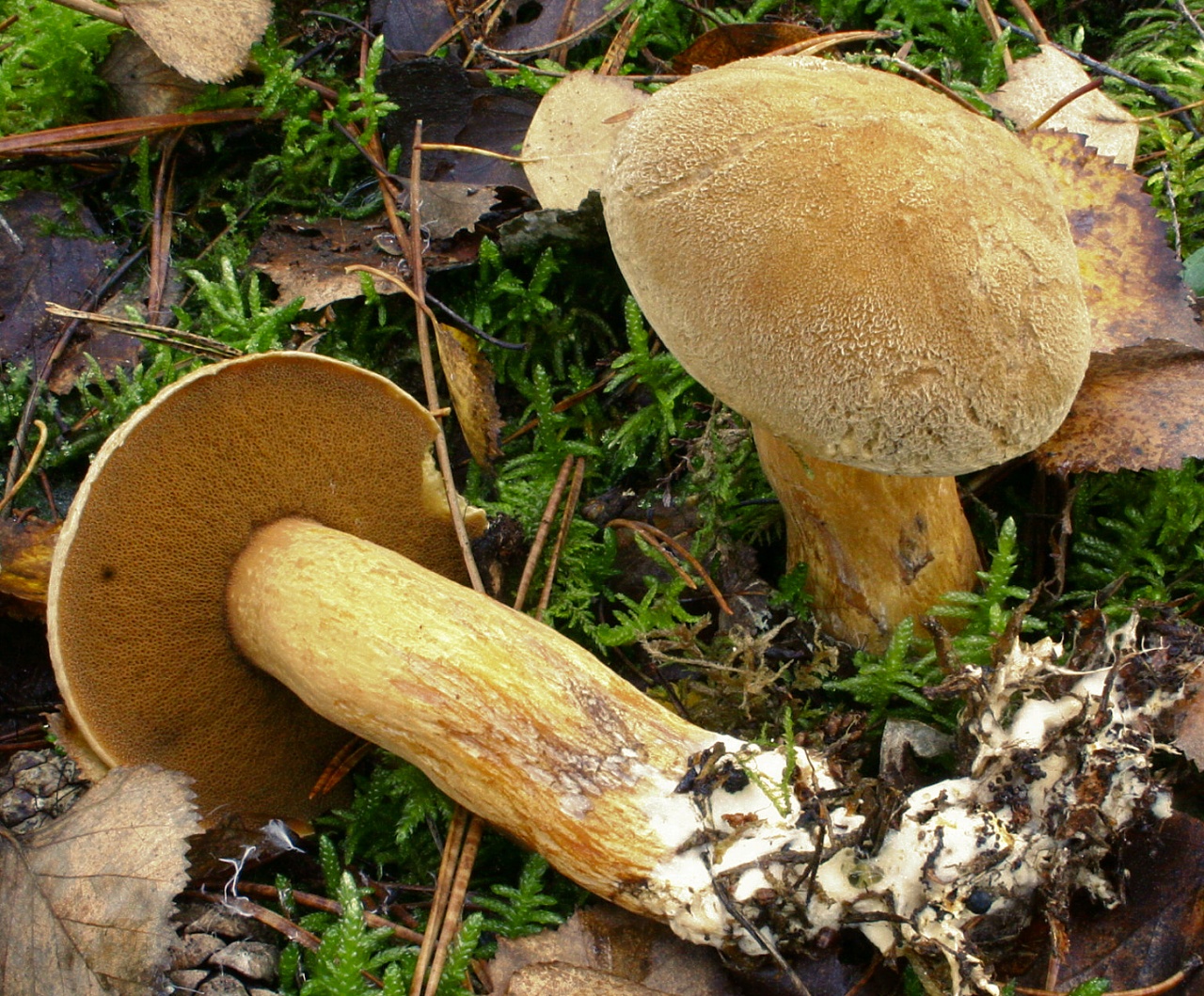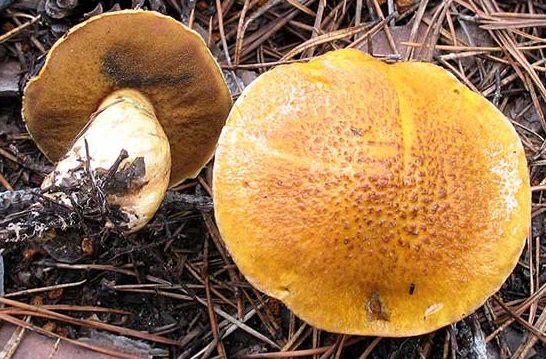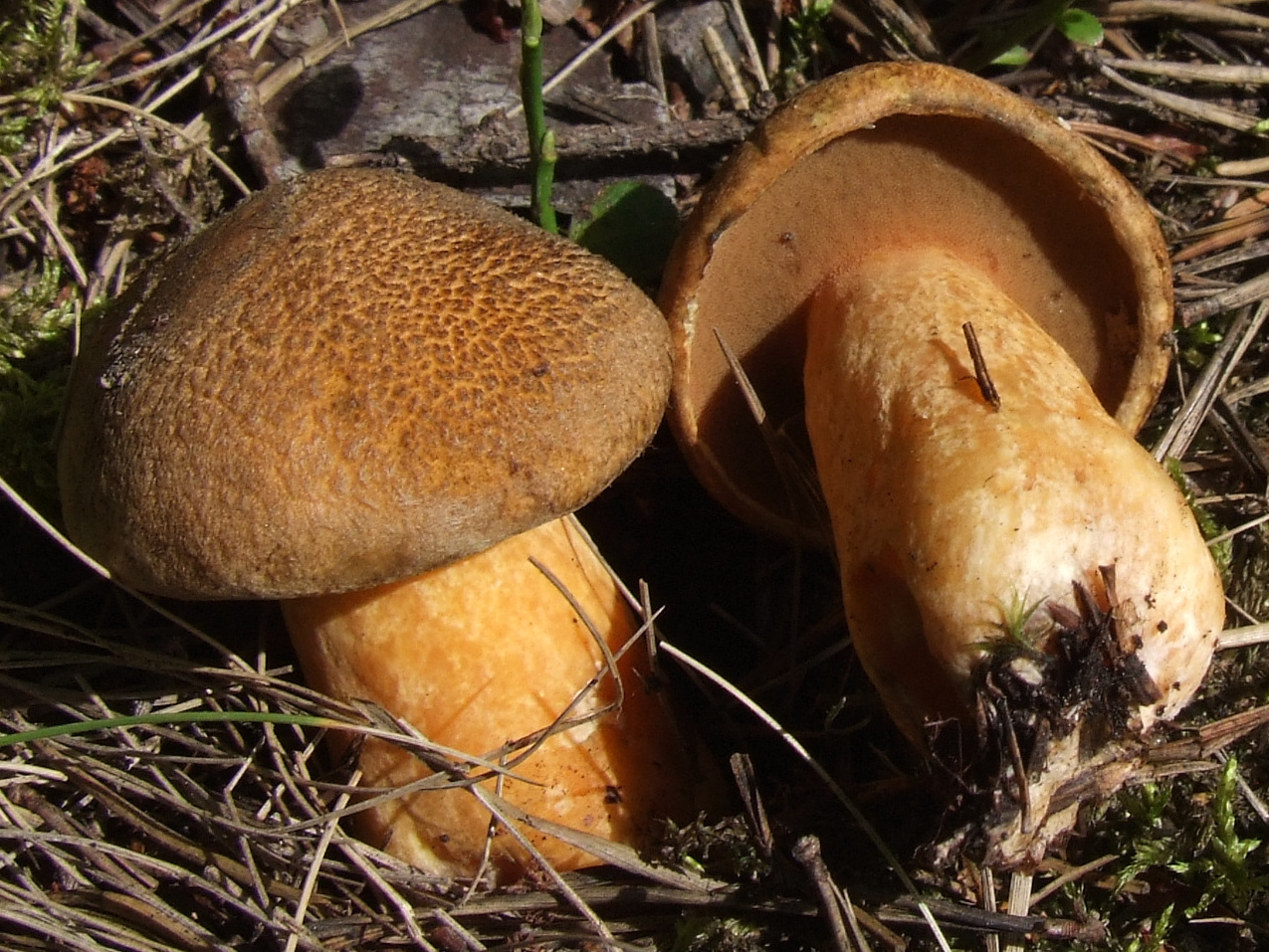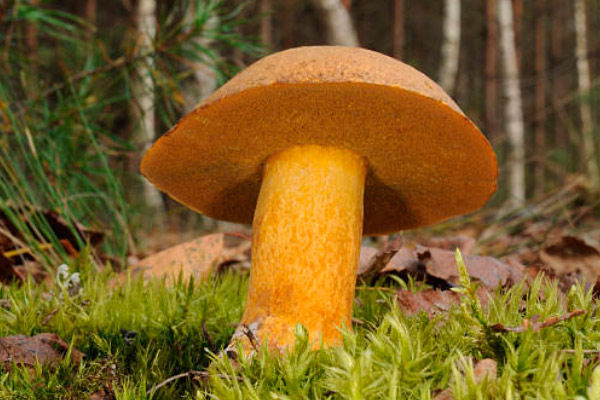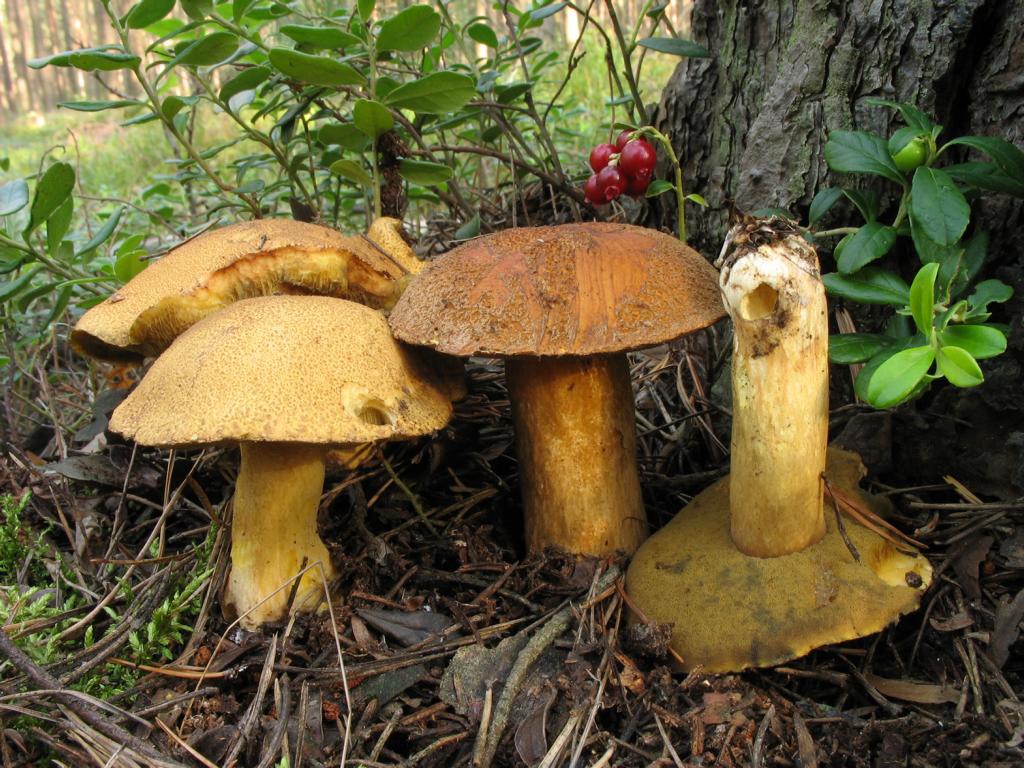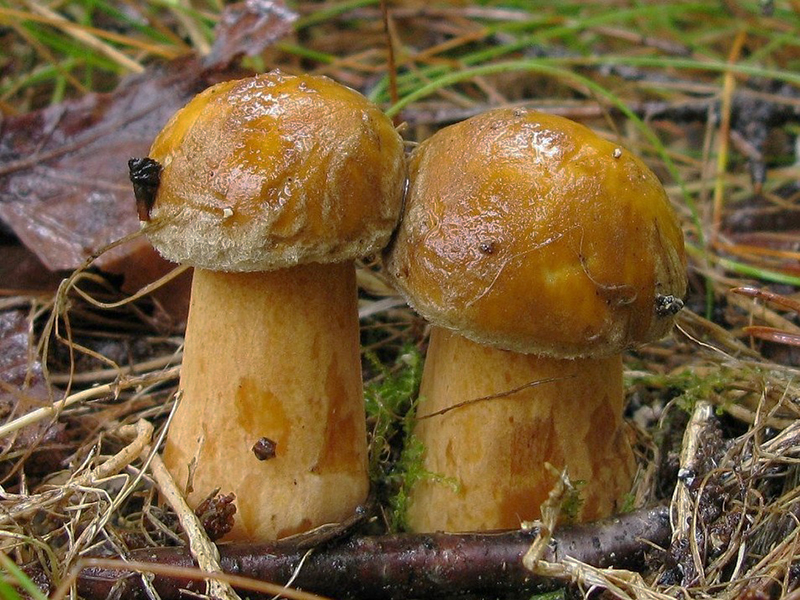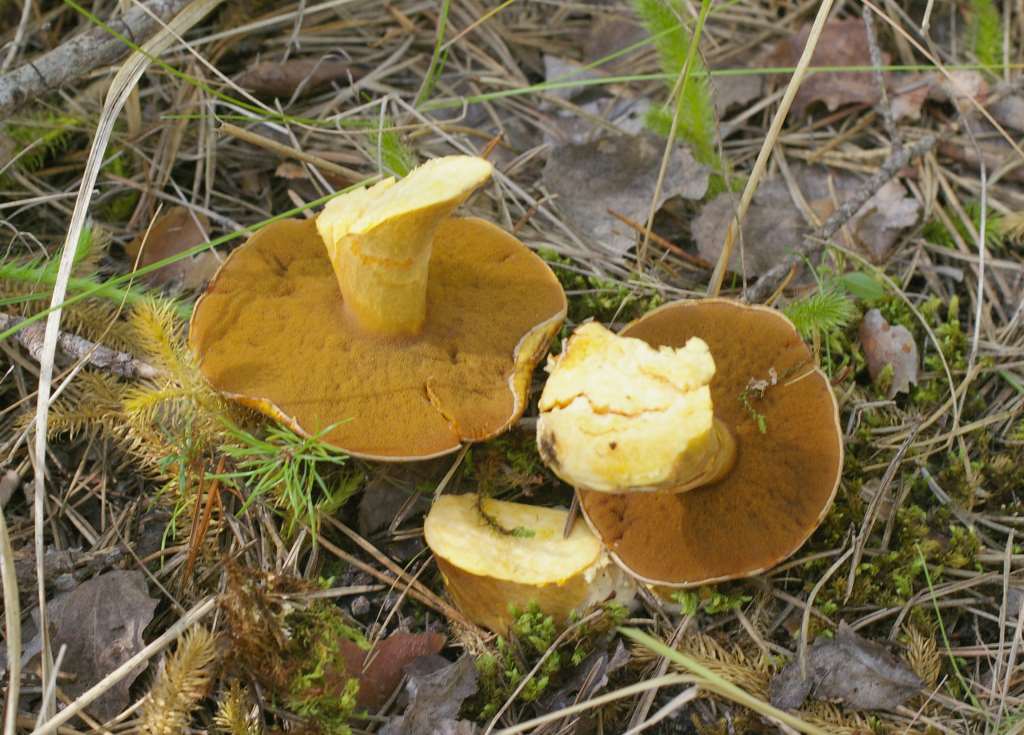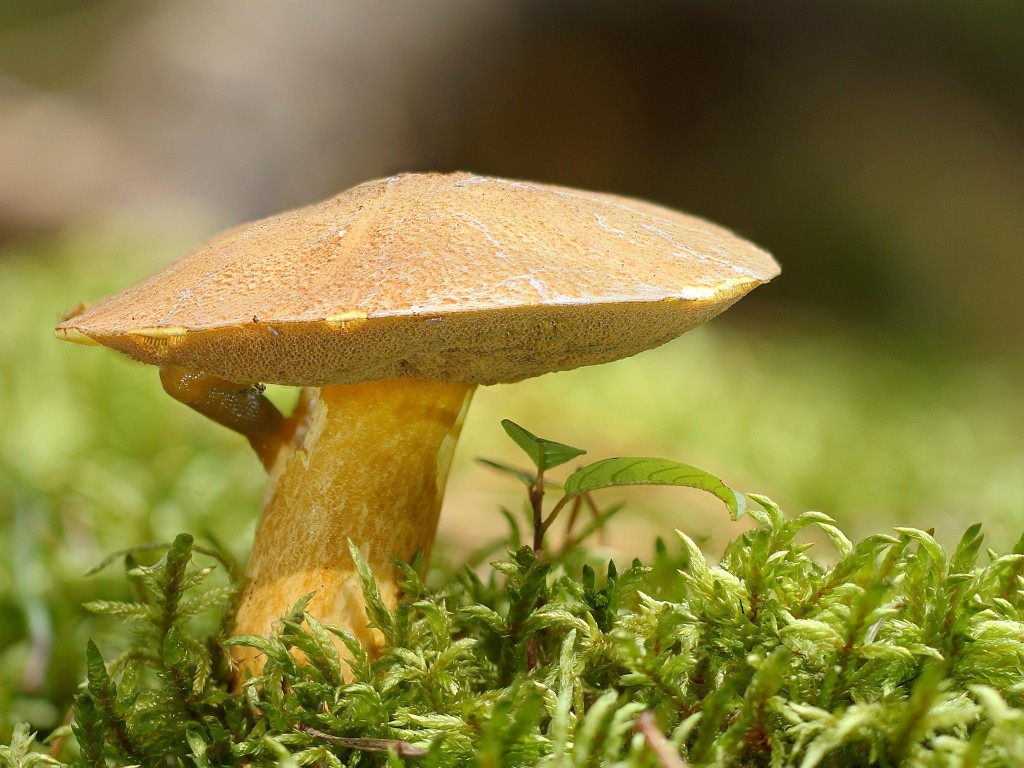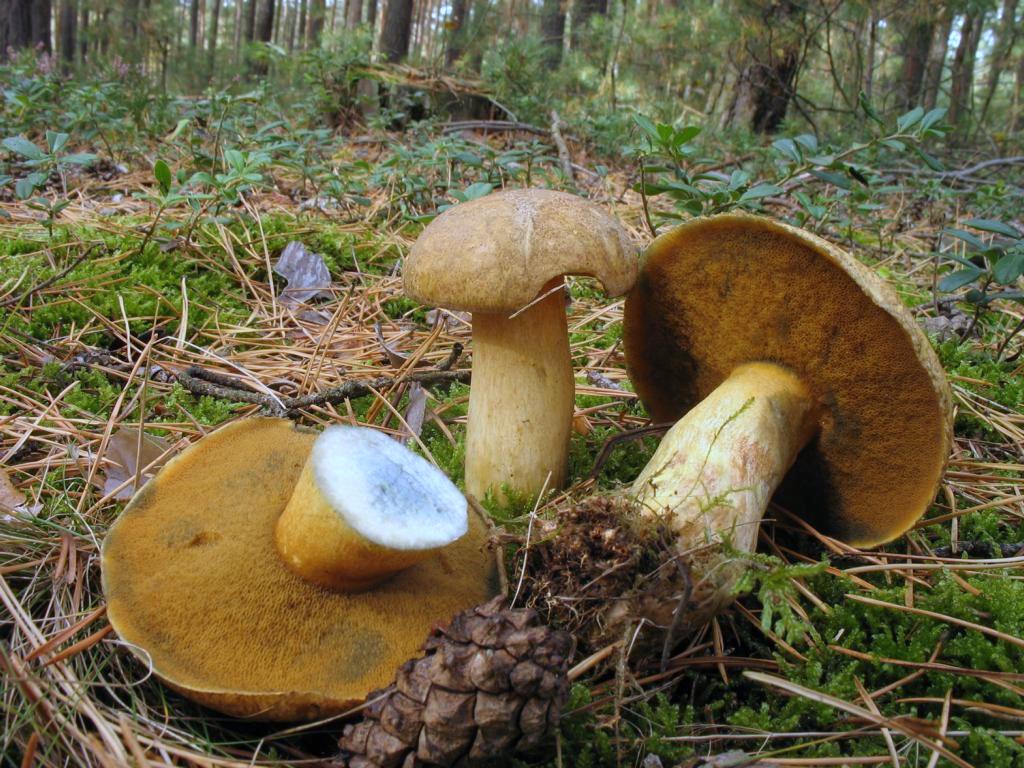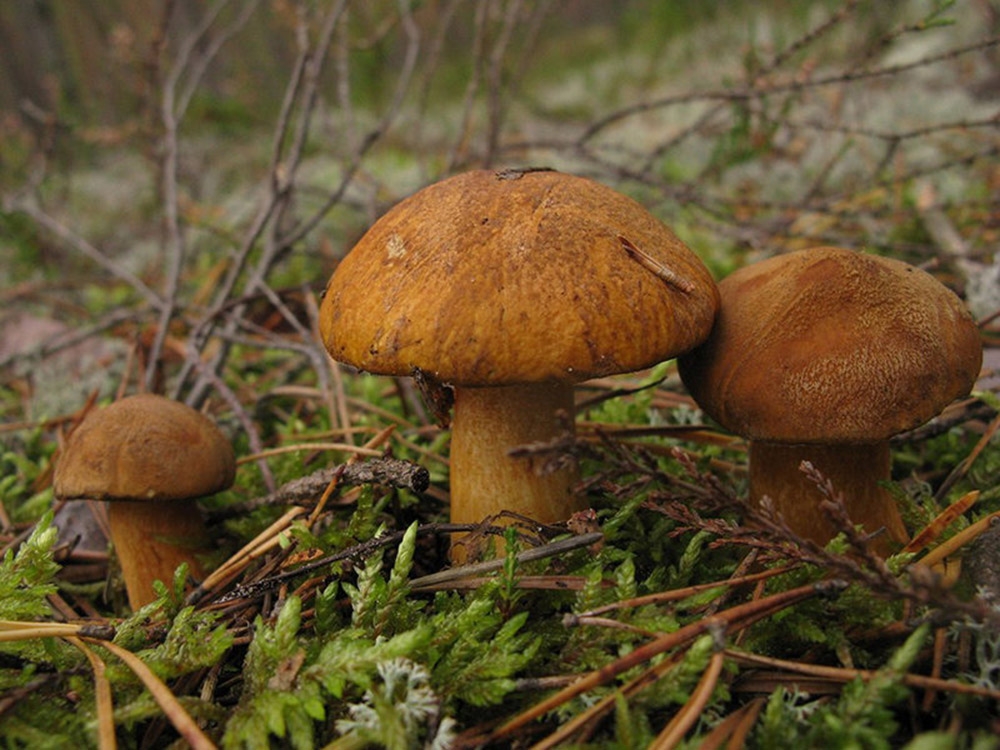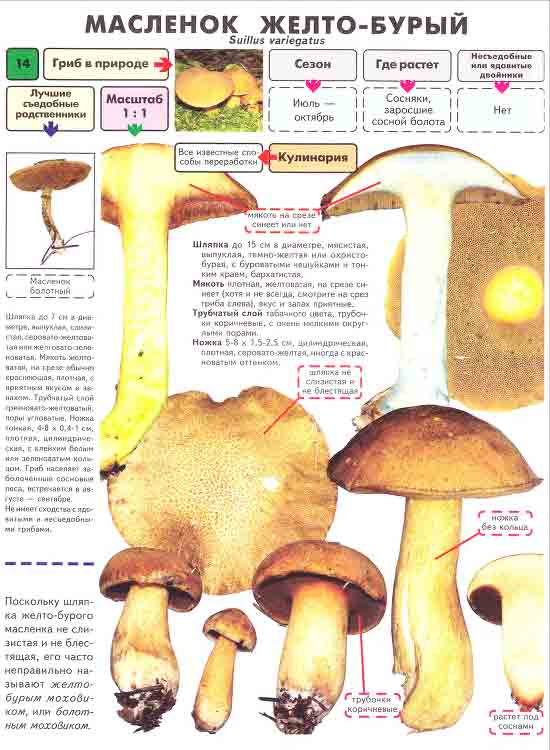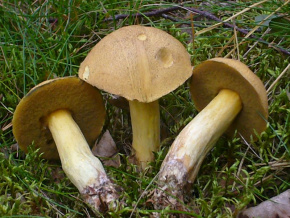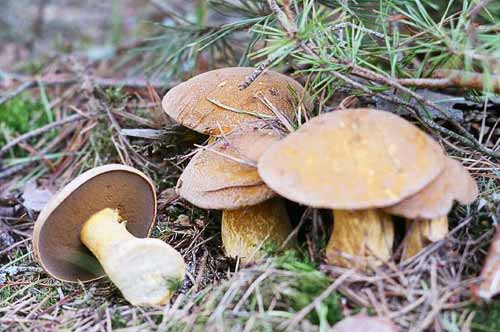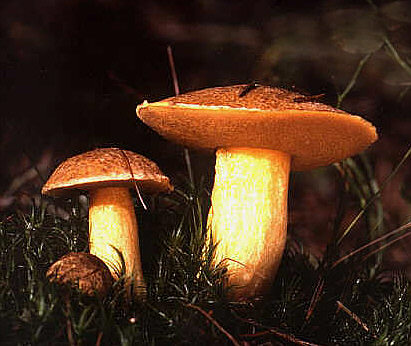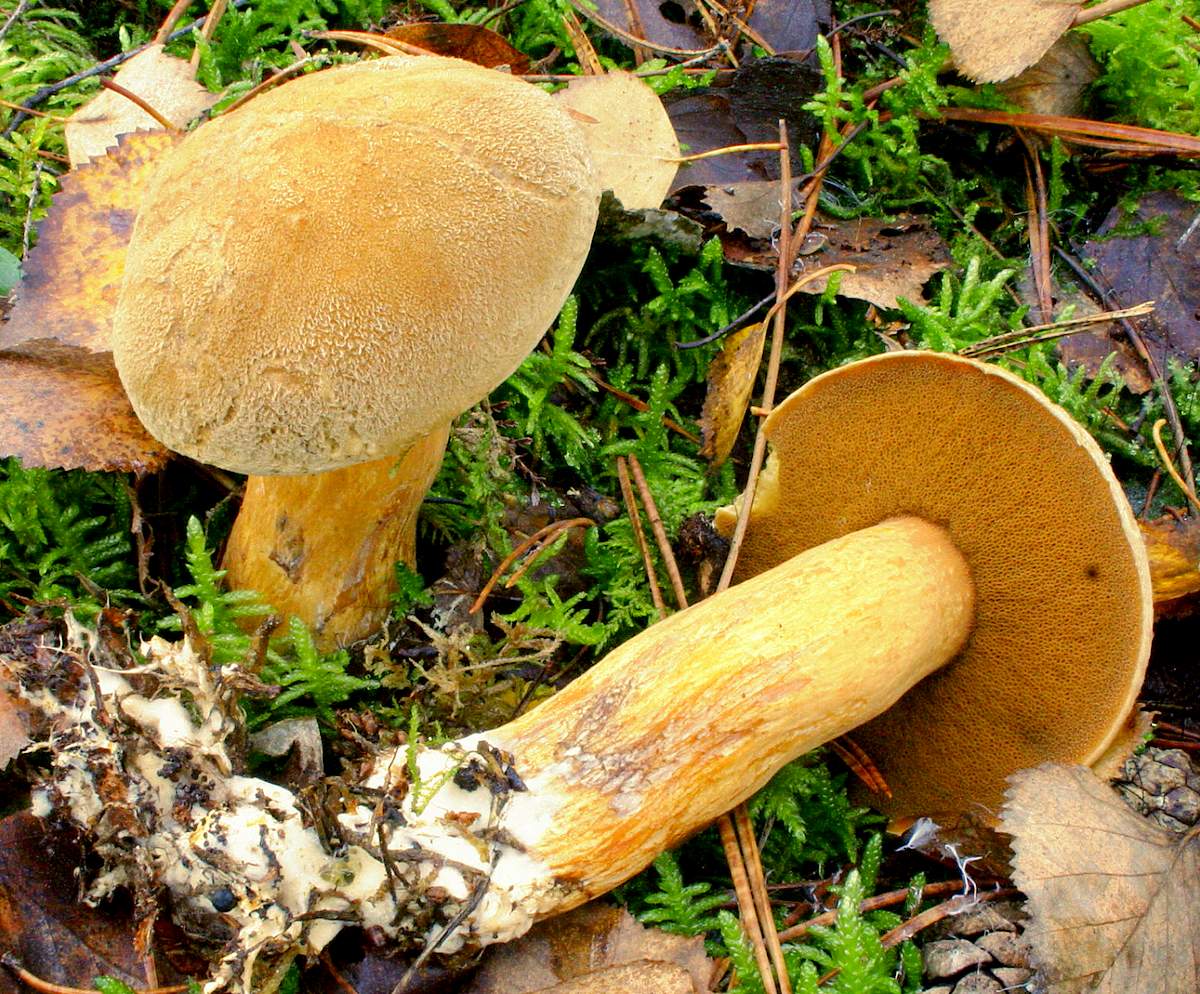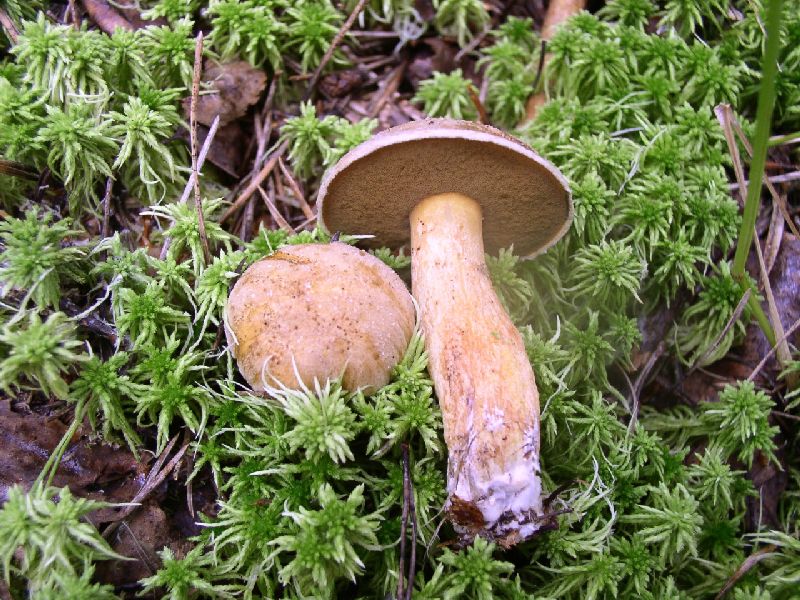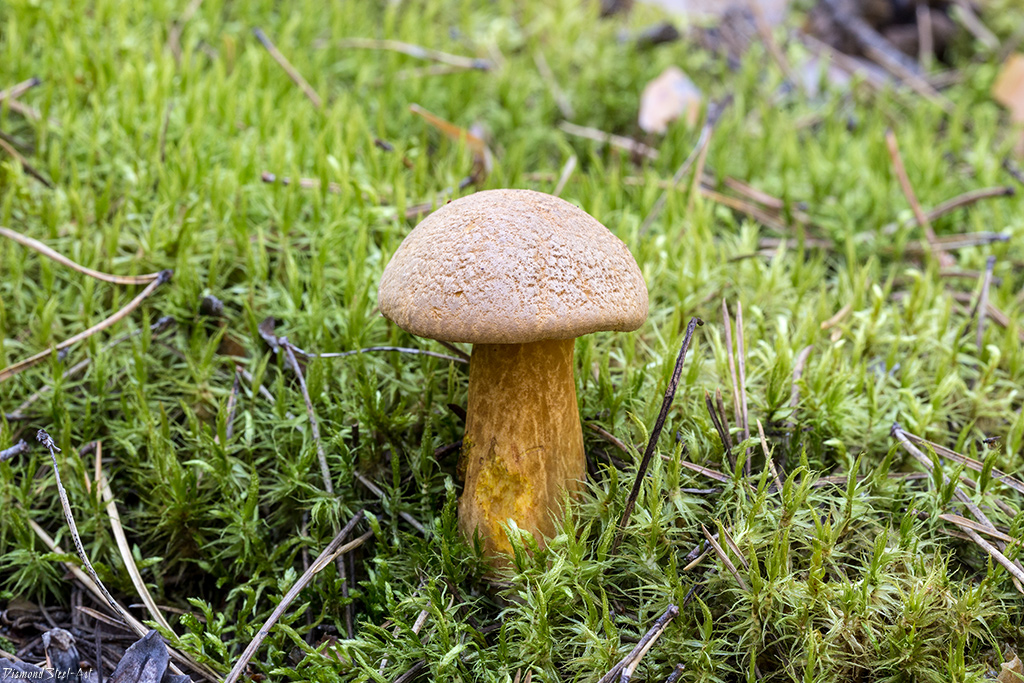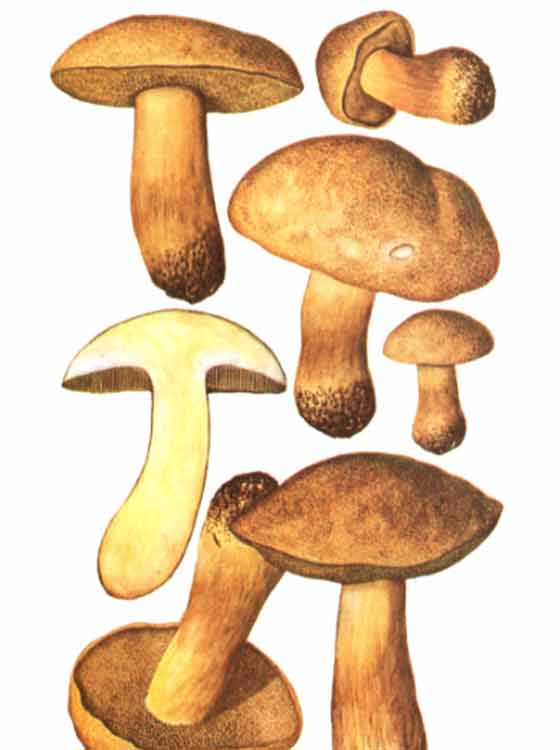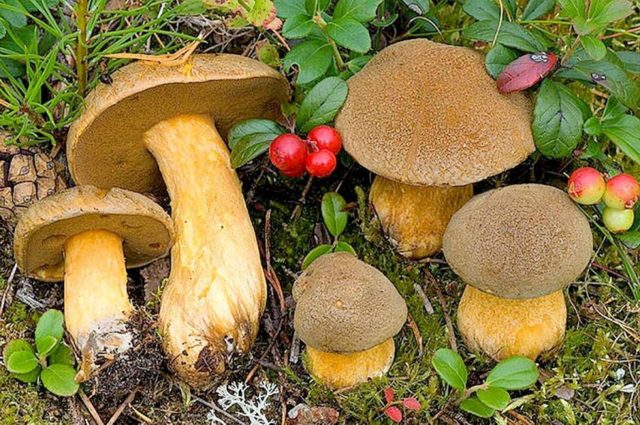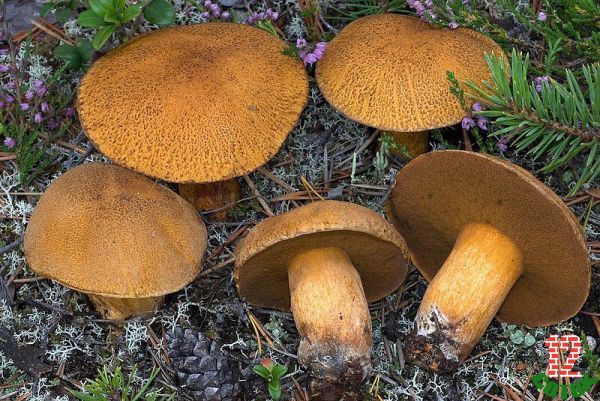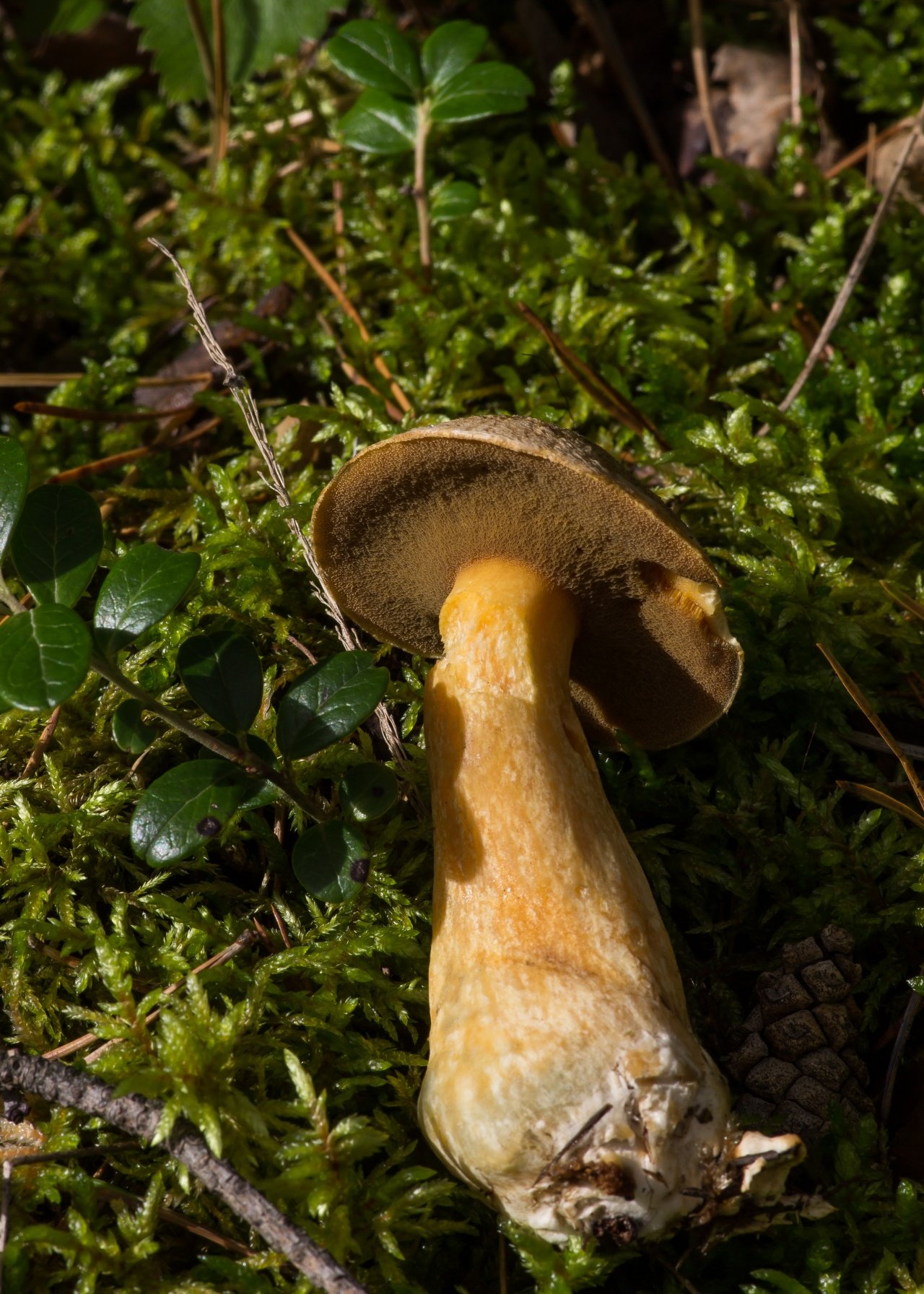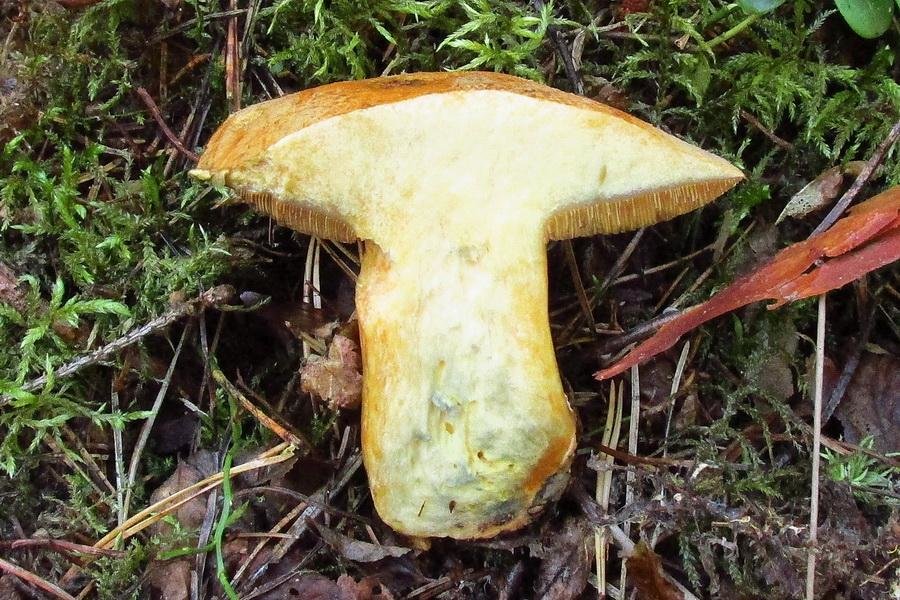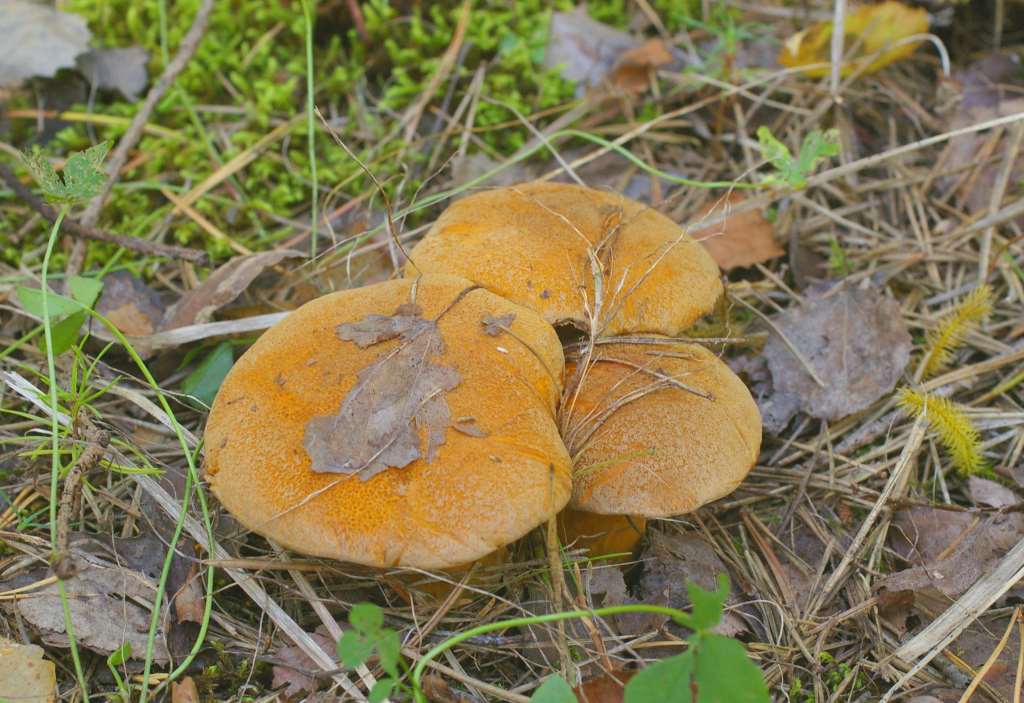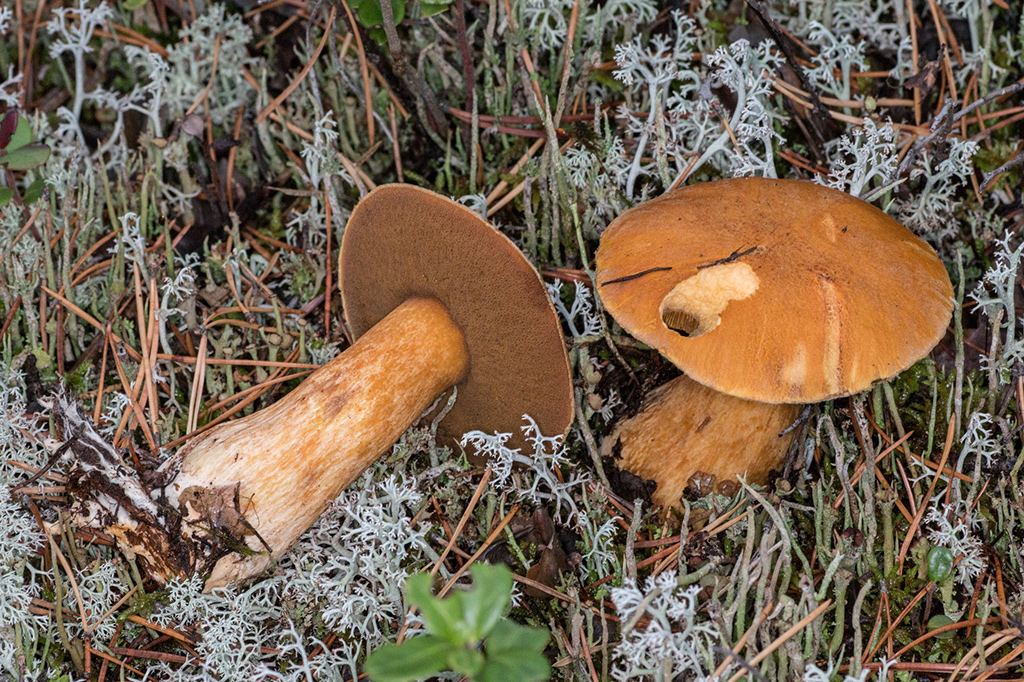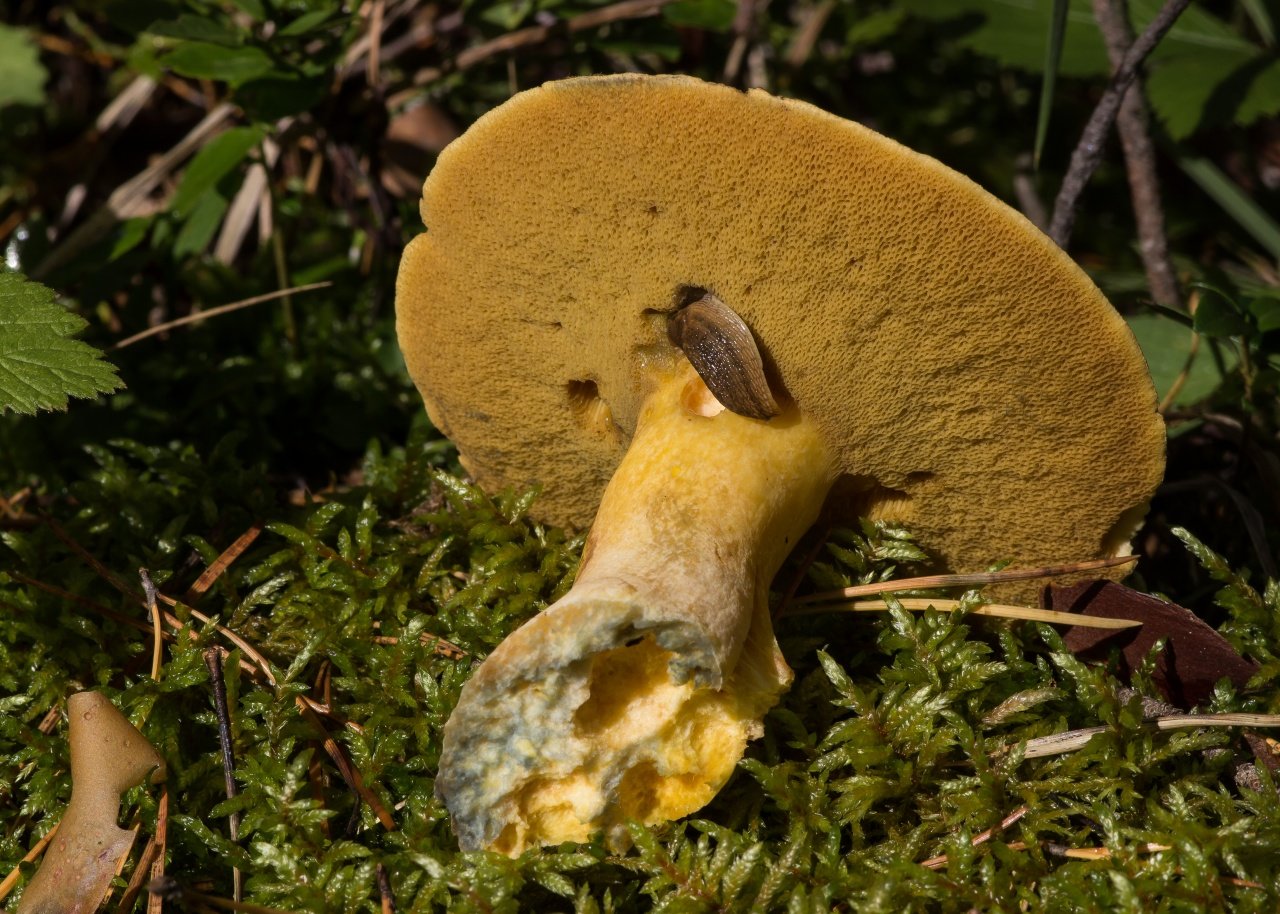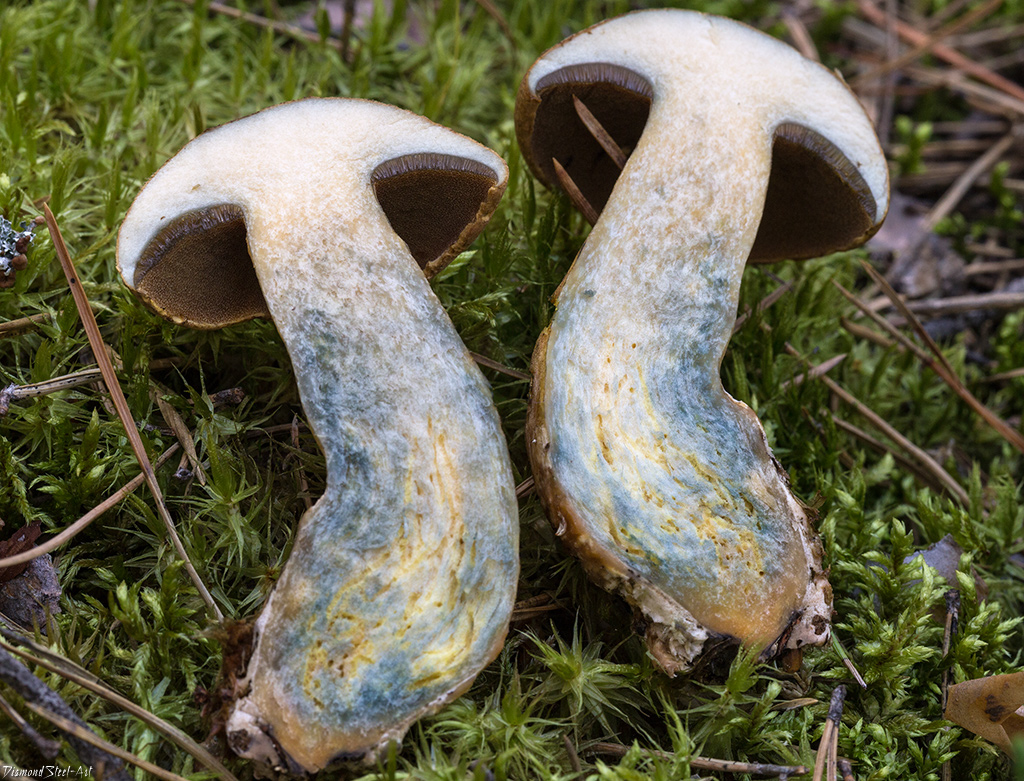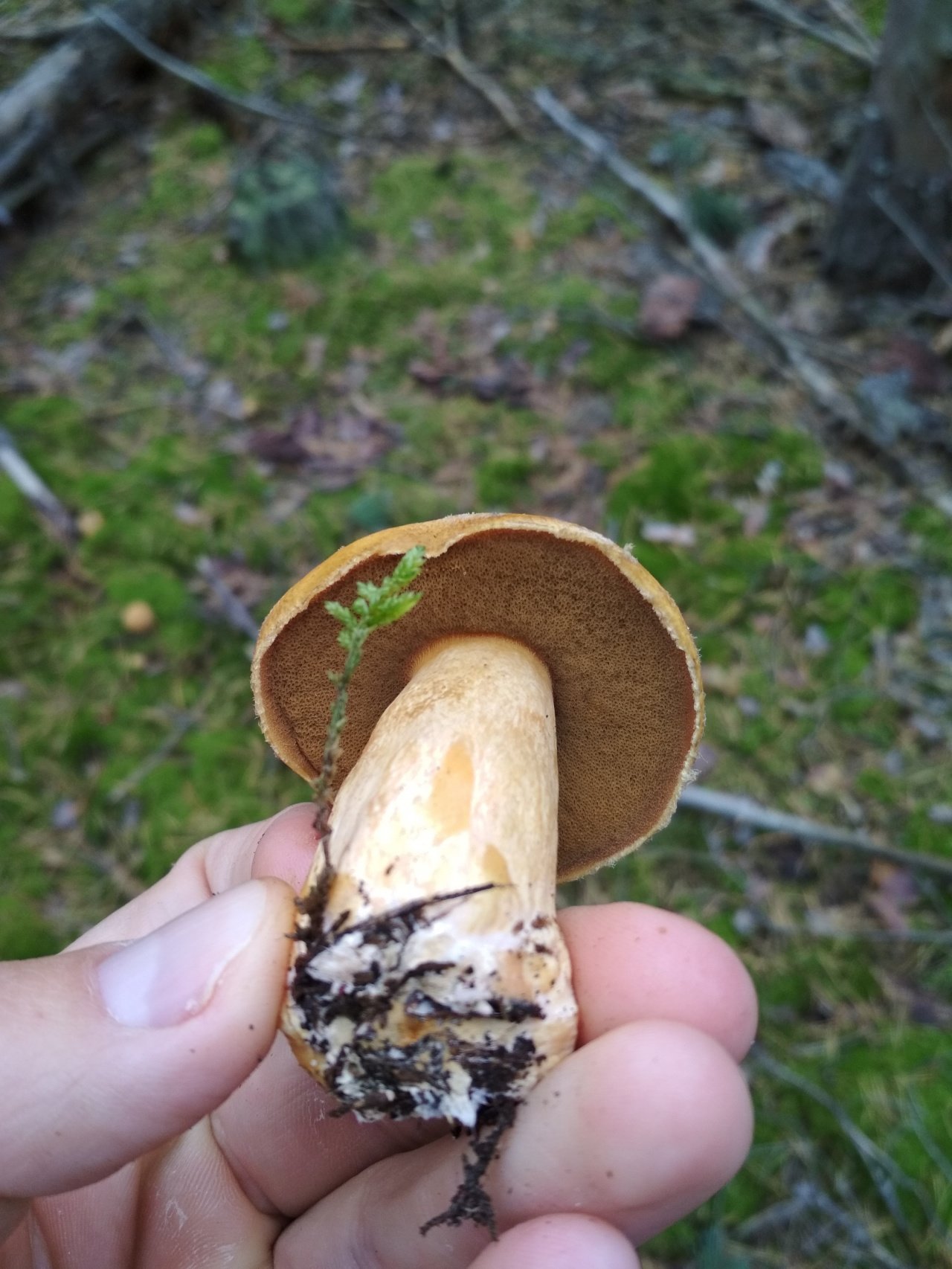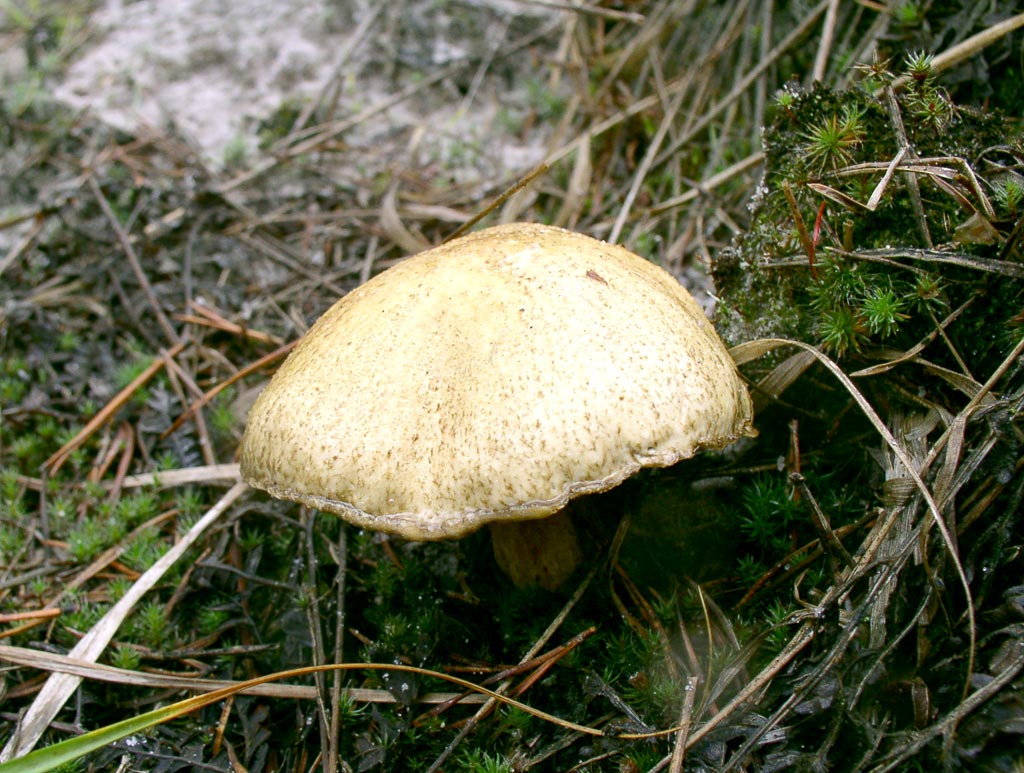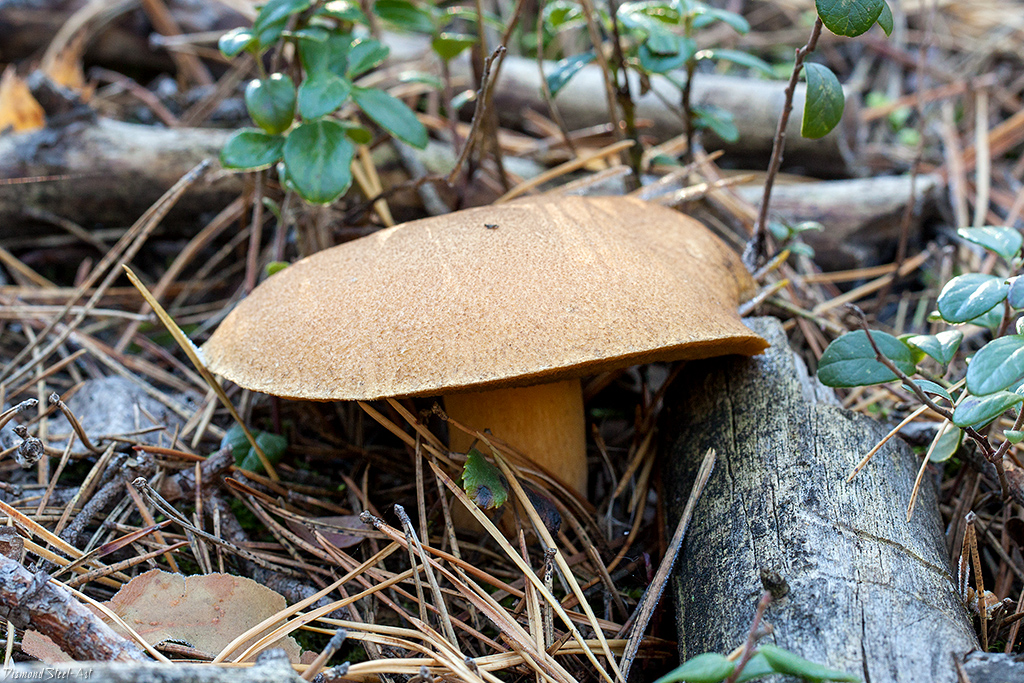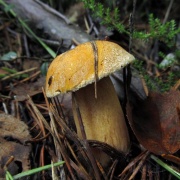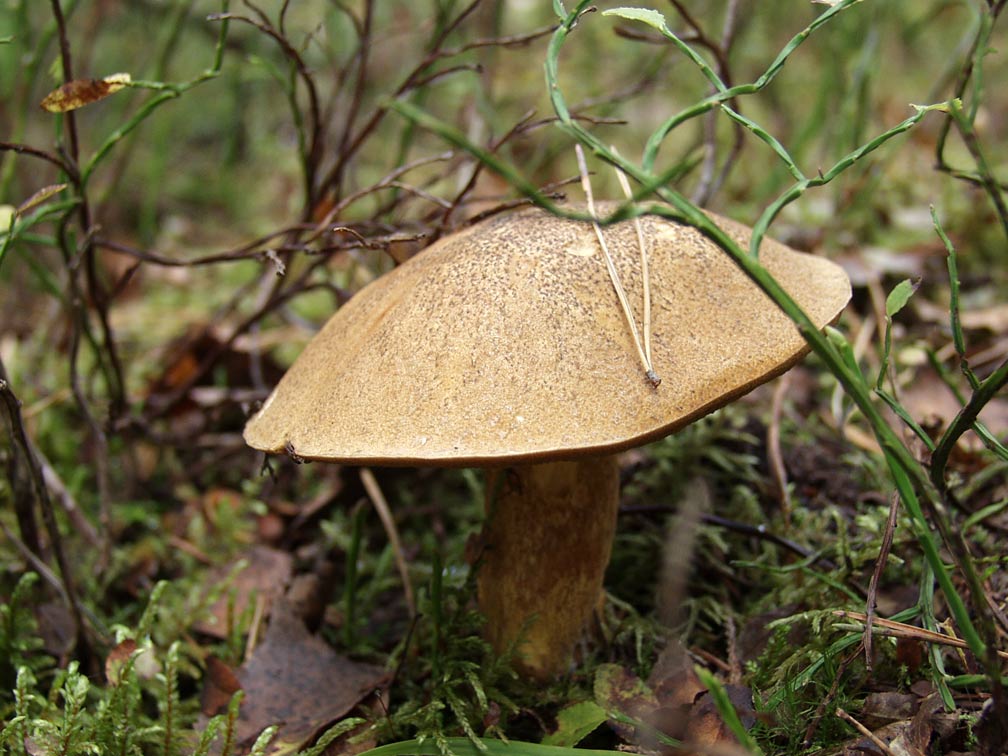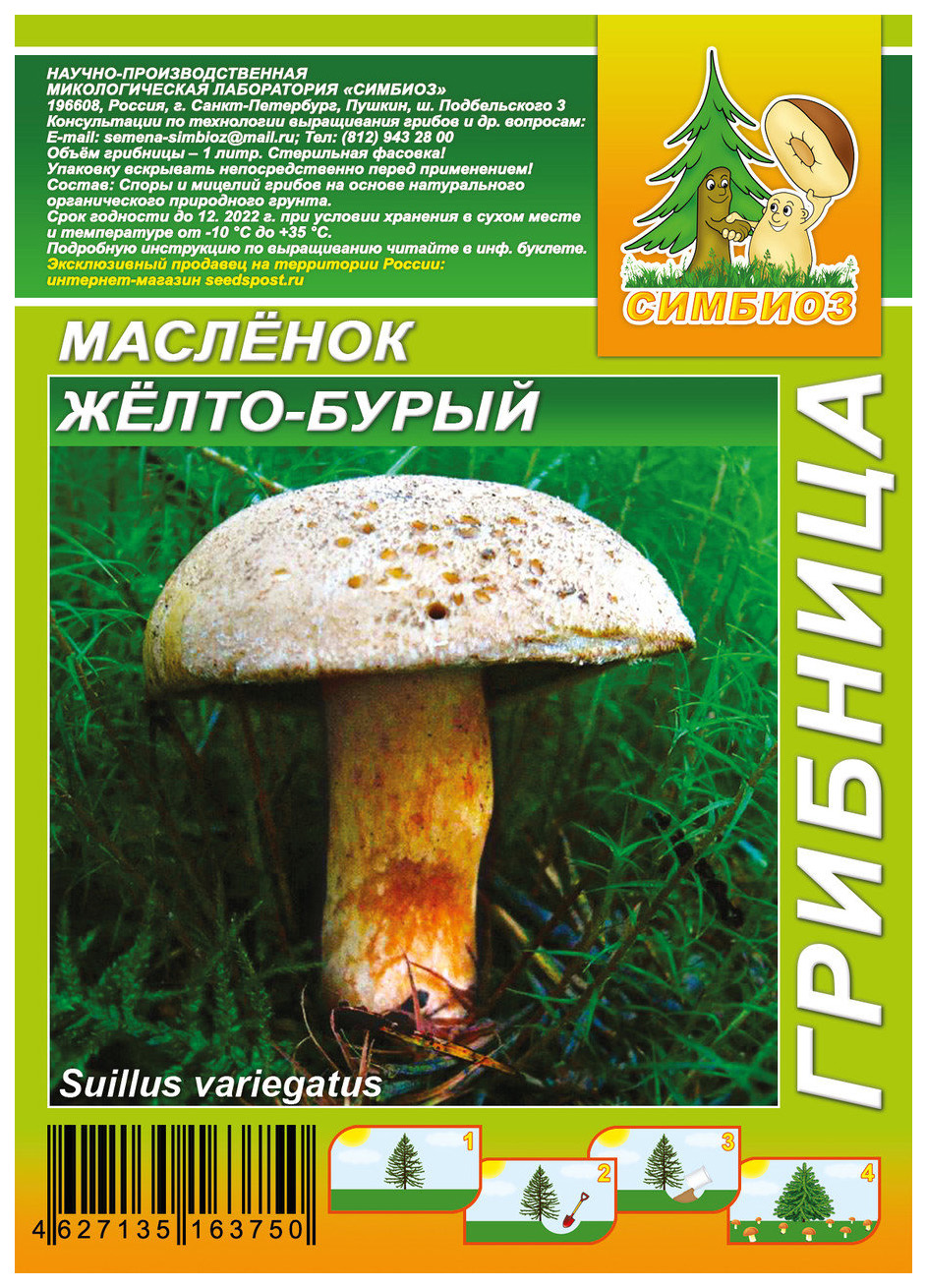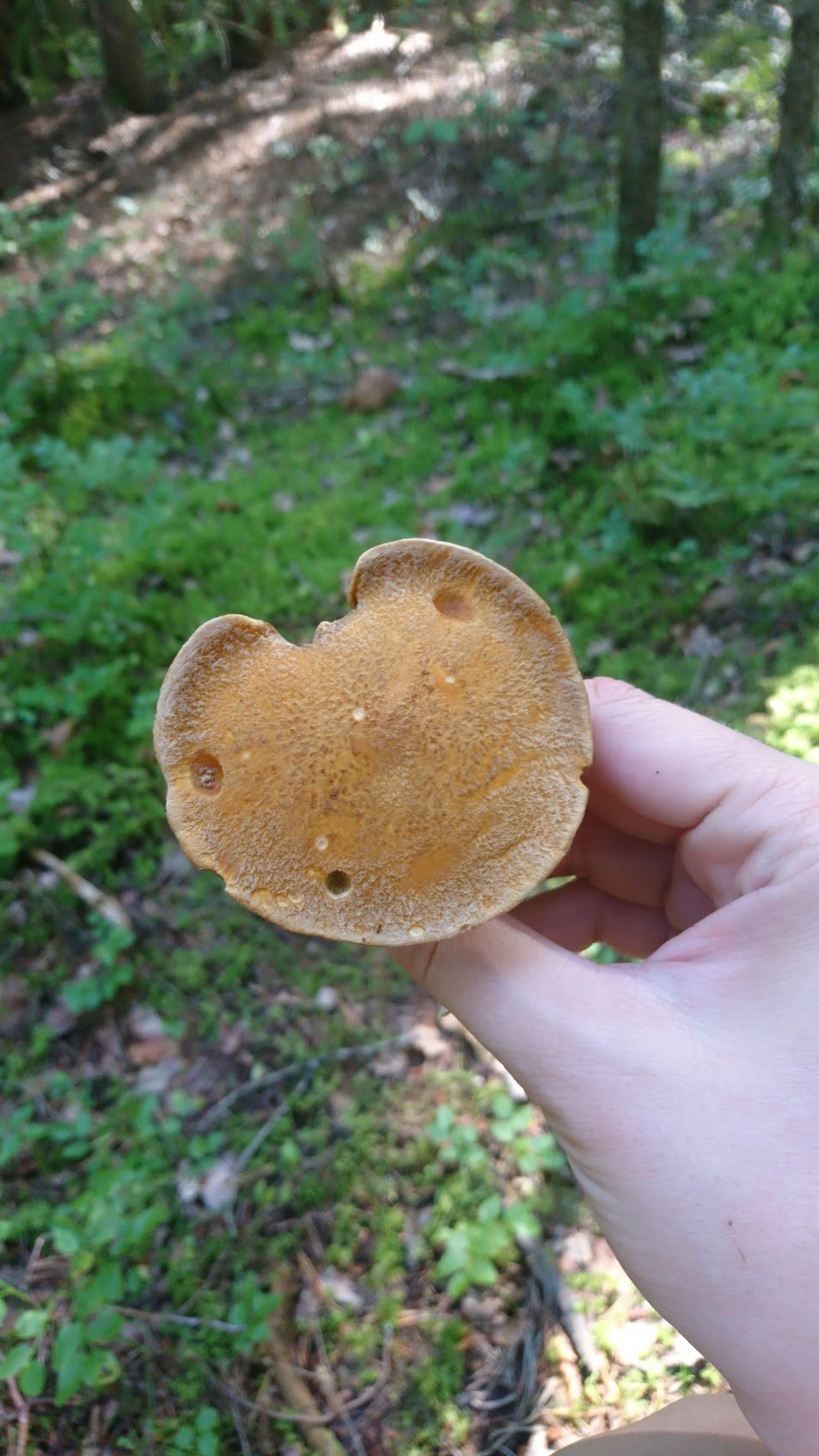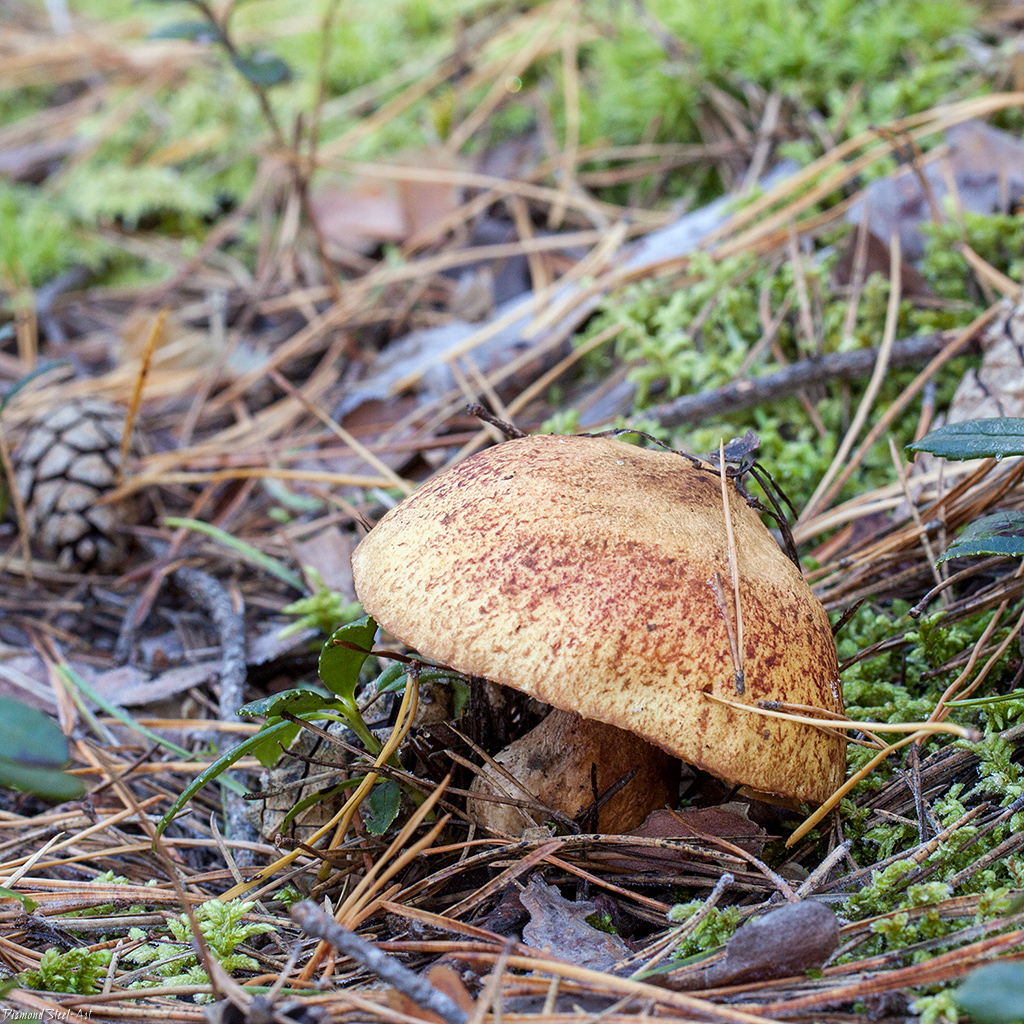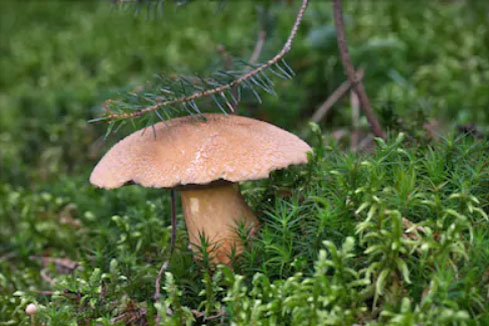Larch oil can: photo and description
Category: edible.
Larch Butter Cap (Suillus grevillei) (diameter 1.5-3 cm): yellow and lemon-gold to brown or brown. In young mushrooms, it is slightly convex, then changes its shape to almost spread. Slightly sticky to the touch, no cracks or bumps. The skin is removed only with pieces of pulp.
Leg (height 3-13 cm): thick and solid, in the form of a cylinder or a club. The color is usually almost the same as that of the cap. There is a lemon-colored ring.
If you look closely at the photo of a larch oiler, you will notice round yellow pores on the tubular layer, darkening with slight pressure.
Flesh: juicy and fibrous. The brown or light yellow color does not change when broken and interacted with air.
Twins: rare gray boletus (Suillus aeruginascens) and rusty red (Suillus tridentinus). Grays have dull caps and legs, while rusty-red ones grow only in Western Siberia and have fibrous scales on the cap.
When it grows: from early July to late September practically throughout Russia (except for the southern regions), as well as in Europe and North America.
Look at the photo of the oiler mushroom in its natural habitat - it can most often be found next to larch trees.
Eating: in almost any form, subject to preliminary boiling and peeling. This mushroom is especially tasty pickled.
Application in traditional medicine (data not confirmed and not passed clinical studies!): As a good remedy for the treatment of gout.
Oiler white: photos and doubles
Category: conditionally edible.
White oiler hat (diameter 6-15 cm): May turn olive in very humid weather. Convex in shape, almost flat in old mushrooms. Smooth to the touch, without wrinkles or cracks, slightly slippery. The skin is easily removable. The edges are yellowish or with a gray tinge. Leg (height 4-11 cm): white, cylindrical, without ring.
As you can see in the photo of the white oiler, the cap is always solid, without hollow areas, sometimes strongly curved. In adult mushrooms, they often have lilac or brown warts.
A photo and description of the pulp of this species of butter is similar to the yellow-brown variety: it is the same dense, yellowish, reddens when broken and interacted with air. It does not have a pronounced smell and taste, therefore the mushroom is considered to be of low quality.
Twins of the white oil can: marsh boletus (Leccinum holopus), Siberian boletus (Suillus plorans) and Siberian (Suillus sibiricus). All three mushrooms are outwardly similar to the white butterdish only at a young age. In the future, the cap of the boletus acquires a greenish tint, and in the boletus it is darker.
When it grows: from early August to late September in Siberia and the Far East, China, North America and European countries bordering the Alps.
Where to find: In coniferous and mixed forests, usually near pine and cedar trees.
Eating: salted and pickled. In cooking, only young mushrooms are used, which should be processed no later than 3-4 hours after harvest.
Application in traditional medicine: not applicable.
Other names: pale oiler, soft oiler.
Description and characteristics of the edible mushroom
Other names for the variegated oiler are marsh flywheel, sandy, yellow-brown, marsh, motley. Scientific name Suillus variegatus. He belongs to the Boletov family.
Hat
Its shape in young specimens is semicircular, with edges curved inward. As it grows, it straightens and resembles a flat pillow with a diameter of 5–14 cm. The color options for the top layer are varied, always with an ocher undertone: yellow, orange, brown, reddish. It gets dark with age.A thin layer of the skin is velvety to the touch, it is difficult to separate from the surface of the fruiting body. In rainy or foggy weather, it becomes slippery, slightly sticky. The mushroom smells like pine needles.
Hymenophore
The lower part of the cap, the hymenophore, is an elastic tubular mass. In the phase of active growth, it is colored pale red or greenish yellow. Until the opening of the cap, the tubes fit snugly to the stem. As the spore powder matures, it increases in diameter and changes its color to dark olive.
Leg
The stem is cylindrical, slightly thickened and darkens downwards. Its thickness can reach 3.5 cm, height - 9 cm. The surface is smooth.
A bit of history
The genus Suillus was first isolated and described by Pierre Antonio Micheli in his work Nova plantarum in 1729. A detailed classification of the family was given by one of the greatest mycologists of the twentieth century, Rolf Singer. Before the beginning of the Second World War, the scientist worked and lived in the USSR.
Larch oil can: photo and description
Category: edible.
Larch Butter Cap (Suillus grevillei) (diameter 1.5-3 cm): yellow and lemon-gold to brown or brown. In young mushrooms, it is slightly convex, then changes its shape to almost spread. Slightly sticky to the touch, no cracks or bumps. The skin is removed only with pieces of pulp.
Leg (height 3-13 cm): thick and solid, in the form of a cylinder or a club. The color is usually almost the same as that of the cap. There is a lemon-colored ring.
If you look closely at the photo of a larch oiler, you will notice round yellow pores on the tubular layer, darkening with slight pressure.
Flesh: juicy and fibrous. The brown or light yellow color does not change when broken and interacted with air.
Twins: rare gray boletus (Suillus aeruginascens) and rusty red (Suillus tridentinus). Grays have dull caps and legs, while rusty-red ones grow only in Western Siberia and have fibrous scales on the cap.
When it grows: from early July to late September practically throughout Russia (except for the southern regions), as well as in Europe and North America.
Look at the photo of the oiler mushroom in its natural habitat - it can most often be found next to larch trees.
Eating: in almost any form, subject to preliminary boiling and peeling. This mushroom is especially tasty pickled.
Application in traditional medicine (data not confirmed and not passed clinical studies!): As a good remedy for the treatment of gout.
Oiler white: photos and doubles
Category: conditionally edible.
White oiler hat (diameter 6-15 cm): May turn olive in very humid weather. Convex in shape, almost flat in old mushrooms. Smooth to the touch, without wrinkles or cracks, slightly slippery. The skin is easily removable. The edges are yellowish or with a gray tinge. Leg (height 4-11 cm): white, cylindrical, without ring.
As you can see in the photo of the white oiler, the cap is always solid, without hollow areas, sometimes strongly curved. In adult mushrooms, they often have lilac or brown warts.
A photo and description of the pulp of this species of butter is similar to the yellow-brown variety: it is the same dense, yellowish, reddens when broken and interacted with air. It does not have a pronounced smell and taste, therefore the mushroom is considered to be of low quality.
Twins of the white oil can: marsh boletus (Leccinum holopus), Siberian boletus (Suillus plorans) and Siberian (Suillus sibiricus). All three mushrooms are outwardly similar to the white butterdish only at a young age. In the future, the cap of the boletus acquires a greenish tint, and in the boletus it is darker.
When it grows: from early August to late September in Siberia and the Far East, China, North America and European countries bordering the Alps.
Where to find: In coniferous and mixed forests, usually near pine and cedar trees.
Eating: salted and pickled.In cooking, only young mushrooms are used, which should be processed no later than 3-4 hours after harvest.
Application in traditional medicine: not applicable.
Other names: pale oiler, soft oiler.
Butter dish yellow-brown
Butter dish yellow-brown - Latin Suillus variegatus
Also, this mushroom is called Sandy Moss, Bolotovik, Variegated Butter, Pestrets, Marsh Moss or yellow-brown Moss.
Description
Mushroom cap
The variegated oil can builds up rather large hats, the diameter of which is 5-14 cm. Young specimens have semicircular "headdresses" with turned-up edges. In mature mushrooms, the hat resembles a pillow.
The hat surface of a young mushroom is covered with an orange-gray or olive pubescent skin, which subsequently cracks and becomes covered with tiny scales. The hats of mature mushrooms lose their scales and become light ocher. Unlike other oils, the skin from Pestrets is removed with great difficulty.
The hats are filled with dense pale yellow or pale orange pulp, which turns lemon yellow in the area where the legs are attached. When the pulp is damaged, it takes on a bluish tinge.
The hat bottom is formed by a tubular mass, which at first grows to the stems and is colored in a pale red or grayish yellow tone. Over time, the tubes acquire a dark olive or brownish olive color. If you cut the tubular layer with a knife, it turns blue.
Sandy flywheel reproduces by elongated, smooth, pale yellow spores that form in an olive-brown spore powder.
Stipe
The yellow-brown oiler grows a well-formed smooth leg in the form of a cylinder or club, reaching 2-3.5 cm in thickness and 3-9 cm in height. It is painted in a pale yellow or lemon color, reddening or reddening closer to the base.
Butter dish yellow-brown - Latin Suillus variegatus
Growing places
These mushrooms prefer the sandy soil of conifers and mixed forests. Most often, such boletus grows in the European regions of Russia, in European countries, in the Caucasian and Siberian lands - both in the plains and in mountain forests.
The variegated butter dish gives massive yields, sometimes grows in separate specimens and in small groups. The fruiting season is from June to early November.
Edibility
Although the flesh of the Bolotovik does not have a pronounced taste and smells of pine needles, the mushroom belongs to 3 categories of edibility.
Many mushroom pickers consider it tasteless because of its metallic taste, so they only marinate it: the marinade improves the taste of the mushrooms. Fried and stewed, these boletus are usually not used.
Evaluation of taste, medicinal properties, benefits and possible harm
White oilers have a strong mushroom smell, but do not have an expressive taste, and therefore belong to the second category of edibility. For their preparation, boiling, frying, drying, freezing, salting and pickling are used.
Butterlets are low-calorie mushrooms, in 100 g there are only 19 kcal. They contain a large amount of vitamin B, carbohydrates, fiber, vegetable protein. Fatty acids, lecithin and various essential oils prevent cholesterol deposition. Oily is one of the few mushrooms that is quite easily absorbed by the body.
White oil can be used to relieve headaches, with gout, as a stimulation of immunity. Antibiotic substances were found in the skin of the fruiting body. Like other mushrooms, it is not recommended to eat them for pregnant and lactating women, children under 7 years old, as well as in cases of individual intolerance.
Description of the yellow-brown flywheel.
The shape of the cap is at first semicircular with edges curled downwards, but later it becomes cushion-shaped. Its diameter can be at different stages of growth from 5 to 14 centimeters. The surface of the cap is at first pubescent, but later it cracks, and small scales appear on it, which disappear with old age.

The color of the cap at a young age is gray-orange or gray-yellow, then it becomes red-brown, and even later - light ocher. Sometimes the surface is slightly slimy. The peel is difficult to separate from the pulp.
There are tubes 8-12 millimeters high under the cap. First, they are adhered to the leg, and then they become a little cut. The color of the tubes is yellow or light orange; in old age it becomes dark olive; if damaged, the tubes turn a little blue. The pores are initially small, later they increase in size. The color of the pores varies from gray-yellow to brown-olive. The color of the spore powder is olive-brown. Spores are smooth, ellipsoid-fusiform.

The mushroom stem is cylindrical or clavate. Inside it is full. Its height is 3-9 centimeters, and the girth reaches 3.5 centimeters. The surface of the stem is smooth, lemon-yellow, and its lower part may be reddish or brownish-orange.
The pulp is tough. The color of the flesh in the cap is light yellow or lemon yellow, and brownish in the lower part of the leg; if damaged, it turns a little blue. The pulp has a characteristic pine smell, but it does not have a pronounced taste.
Areas of growth of yellow-brown mushrooms.
Yellow-brown flywheels inhabit the sandy soil of mixed and coniferous forests. They bear fruit from June to November. They are often found in very large numbers, but single specimens can also be found.

This type of moss is known in Europe. In our country, yellow-brown moss grows in the European part, in the Caucasus and Siberia.
Evaluation of the edibility of yellow-brown flyworms.
These are edible mushrooms, according to their taste, they correspond to the 3rd category. Yellow-brown flywheels are not considered too tasty, but they are not bad when pickled.

Butter dish (Suillus luteus)
- Other names for the mushroom:
- Ordinary butter dish
- Butter dish yellow
- Late butter dish
- Autumn butter dish
Synonyms:
- Boletus luteus
- Boletopsis lutea
Butter dish (Suillus luteus) is the scientific name of the most common type of butter. The word luteus in the scientific name of the mushroom means "yellow".
Growth:
Oily can grow on sandy soil from late May to November in coniferous forests. Fruiting bodies appear singly or most often in large groups.
External description
Hat:
The cap of the present Oily (Suillus luteus) reaches a diameter of up to 10 cm, convex, later almost flat with a tubercle in the middle, sometimes with upward curved edges, chocolate-brownish, sometimes with a purple tint. The skin is radially fibrous, very slimy and easily separated from the pulp. The tubules are initially pale yellow, later dark yellow, adherent to the peduncle, 6-14 mm long. The pores are small, in young mushrooms pale yellow, later bright yellow, brownish yellow. Tubular layer adherent to the pedicle, yellow, the pores are at first whitish or pale yellow, then yellow or dark yellow, small, rounded.
Leg:
Cylindrical, solid, 35-110 mm high and 10-25 mm thick, lemon-yellow at the top, brownish and longitudinally fibrous at the bottom. A white filmy blanket, which first connects the leg to the edge of the cap, leaves pieces on the leg in the form of a black-brown or purple ring. Above the ring, the leg is mealy.
Pulp:
The cap is soft, juicy, slightly fibrous at the stem, whitish at first, later lemon-yellow, rusty-brownish at the base of the stem.
Spore powder:
Brown.
Spores: 7-10 x 3-3.5 µm, ellipsoid-fusiform, smooth, pale yellow.
Similarity
The red butter dish (Suillus fluryi) is very similar to the real butter dish, which is distinguished by the absence of a ring on the leg. It has no resemblance to poisonous mushrooms.
Use
Real butter dish - Edible, tasty mushroom of the second category, in taste, it is very close to porcini mushrooms. It is better to remove the skin from the cap before use. It is consumed dried, fresh, pickled and salted. Delicious and easily digestible mushroom. Suitable for preparing soups, sauces and side dishes for meat dishes.To be pickled.
Spreading
The optimum average daily temperature for fruiting the oiler is + 15 ... + 18 ° C, but the ordinary oiler does not react strongly to temperature fluctuations. Fruiting bodies of boletus usually appear 2-3 days after rain, and strong dew also stimulates fruiting. In mountainous areas, boletus can grow massively around stones, this is due to the condensation of moisture on the surface of the stone. Fruiting ceases at a temperature of -5 ° C on the surface of the soil, and after freezing of the upper layer by 2-3 cm, it does not resume. In the summer (at the beginning of the season) boletus is often damaged by insect larvae, sometimes the proportion of unsuitable "wormy" boletus reaches 70-80%. In autumn, insect activity decreases sharply.
Butter dish is widespread in the Northern Hemisphere, prefers a moderately cold climate, but it is also found in the subtropics, sometimes it is accidentally introduced by humans into tropical regions, where it forms local populations in artificial pine plantations.
In Russia, boletus is widespread in the European part, in the North Caucasus, in Siberia, in the Far East. Fruiting more often in large groups.
Season June - October, massively from September.
Features of the mushroom:
Boletus edulis (boletus) are ahead of boletus edulis in terms of the content of fats and carbohydrates. Real butter dish - One of the most common types of edible mushrooms, it takes first place in its yield in coniferous forests.
Description oiler yellow-brown
The shape of the cap at the yellow-brown oiler is initially semicircular with curved edges, but over time it becomes cushion-shaped. The diameter of the cap is 5-14 centimeters. The color of the cap is olive, gray-orange, gray-yellow, then brown-red or light ocher.
The tubules of young mushrooms, adherent to the stem, later become slightly cut. The color of the tubes is initially light orange or yellow, but becomes dark olive as it grows. On the cut, the tubes turn a little blue. The pores are small at first, then they become larger, gray-yellow or light orange in color, and then brown-olive.
The leg is clavate or cylindrical. Its height is 3-9 centimeters, and its thickness is 2-3.5 centimeters. The surface of the leg is smooth, lemon-yellow in color, and the lower part is reddish or orange-brown. The spore powder is olive-brown. Spores are smooth, ellipsoid-fusiform, light yellow in color.
The pulp is tough, light yellow or light orange; above the tubes, the pulp is lemon yellow, and at the base of the stem is brown. On the cut, the pulp turns a little blue. The pulp does not have a special taste, but it has a coniferous aroma.

Areas of growth of yellow-brown boletus
These mushrooms grow on sandy soil. There are yellow-brown boletus in coniferous and mixed forests. They bear fruit in June-November. They can often be found in large numbers. Fruiting bodies can appear singly or in groups.
These mushrooms are known in Europe, in our country they are common in the European part, they also grow in the Caucasus and Siberia. Found in mountainous areas.
The use of yellow-brown oil
Butter yellow-brown are edible make-up, according to their taste, they are referred to the 3rd category. Although it is a little known mushroom, it tastes good. Young mushrooms are best marinated.

Other mushrooms of this genus
The painted oiler has a cap with a diameter of 3-15 centimeters. At the edges of the cap, you can often see the remnants of the bedspread in the form of flakes. The shape of the cap is conical, cushion and flat-cushion. In different weather, the shade of the cap becomes brighter or paler. The color can be red, burgundy brown, brick red, wine red, or may turn yellow. The cap is covered with small gray-brown scales.
The leg length ranges from 4 to 12 centimeters and the width is 1.5-2.5 centimeters. The base is thickened. The color of the leg is yellow, and in the lower part it is rich ocher. The leg is completely covered with red-brown scales, which dry out over time.
Painted oil plants begin to appear in early summer, and fruiting ends in September. These mushrooms prefer fertile soils. They often grow in whole mushroom colonies. Painted oil plants form mycorrhiza with cedar pines. They grow in Siberia, in the Far East, are rarely found in European countries, for example, in Germany. In addition, they are widespread in North America.

Painted butters are edible mushrooms, they can be boiled, fried, soups made from them. They can be eaten even raw.
The Bellini oiler is characterized by a hat with a diameter of 6-14 cm. The color of the hat is brown or white. The surface of the cap is smooth. The shape of the cap at a young age is hemispherical, and then becomes convex-flattened. The leg is massive, small - 3-6 centimeters long and 2-3 centimeters thick. At the base, the leg becomes thinner and more curved. The color of the leg is white-yellow.
Bellini's oiler prefers coniferous or pine forests. These mushrooms do not impose any requirements on the composition of the soil. They can grow both in groups and singly. They bear fruit exclusively in autumn. Bellini butters are edible mushrooms that can be boiled and pickled.

Definitioner
- Basidia (Basidia)
-
Lat. Basidia. A specialized structure of sexual reproduction in fungi, inherent only in Basidiomycetes. Basidia are terminal (end) elements of hyphae of various shapes and sizes, on which spores develop exogenously (outside).
Basidia are diverse in structure and method of attachment to hyphae.
According to the position relative to the axis of the hypha, to which they are attached, three types of basidia are distinguished:
Apical basidia are formed from the terminal cell of the hypha and are located parallel to its axis.
Pleurobasidia are formed from lateral processes and are located perpendicular to the axis of the hypha, which continues to grow and can form new processes with basidia.
Subasidia are formed from a lateral process, turned perpendicular to the axis of the hypha, which, after the formation of one basidium, stops its growth.
Based on morphology:
Holobasidia - unicellular basidia, not divided by septa (see Fig. A, D.).
Phragmobasidia are divided by transverse or vertical septa, usually into four cells (see Fig. B, C).
By type of development:
Heterobasidia consists of two parts - hypobasidia and epibasidia developing from it, with or without partitions (see Fig. C, B) (see Fig. D).
Homobasidia is not divided into hypo- and epibasidia and in all cases is considered holobasidia (Fig. A).
Basidia is the place of karyogamy, meiosis and the formation of basidiospores. Homobasidia, as a rule, is not functionally divided, and meiosis follows karyogamy in it. However, basidia can be divided into probasidia - the site of karyogamy and metabasidia - the site of meiosis. Probasidium is often a dormant spore, for example in rust fungi. In such cases, probazidia grows with metabasidia, in which meiosis occurs and on which basidiospores are formed (see Fig. E).
See Karyogamy, Meiosis, Gifa.
- Pileipellis
-
Lat. Pileipellis, skin - differentiated surface layer of the cap of agaricoid basidiomycetes. The structure of the skin in most cases differs from the inner flesh of the cap and may have a different structure. The structural features of pileipellis are often used as diagnostic features in descriptions of fungi species.
According to their structure, they are divided into four main types: cutis, trichoderma, hymeniderma and epithelium.
See Agaricoid fungi, Basidiomycete, Cutis, Trichoderma, Gimeniderm, Epithelium.
Oiler red-red
Oiler reddish-red - Latin Suillus tridentinus
In a different way, this mushroom is called the Trident Butter or the Trentine Butter.
Description
Mushroom cap
The diameter of the Tridentan Oiler's hats is 50-150 mm. At a young age, they have the shape of a hemisphere or pads, later they become more open and flat.
The hat is covered with a rough skin dotted with many fibrous reddish-orange scales that run radially and give the hat a cracked appearance. In rainy weather, it becomes covered with mucus. The colors of the "headwear" are orange - yellow, pale orange, red - orange or red - brown. The older the Trentian Butter, the darker the color of the hat. Occasionally, flaky pieces of white bedspreads remain on the edges of the hats.
The hats are filled with a tight, fleshy pulp of a yellowish, lemon-yellow, just yellow or yellow-brown hue. If damaged, it turns reddish.
The hat bottom consists of an accreted tubular layer of yellowish or orange-yellow tubes with large pores and torn edges, running down the legs. The pores are irregular and angular.
The reddish-red oiler reproduces by elongated yellowish-olive spores that form in an olive-yellow or olive-brownish spore powder.
Stipe
Legs of reddish-red boletus usually taper upwards, occasionally downwards, and reach 10-35 mm in thickness and 40-100 mm in length. The leg has the shape of a cylinder and a filmy ring left over from the bedspread.
Above the ring, it turns yellowish and is covered with a fine mesh, below the ring, the leg is yellow-orange. Closer to the base, a longitudinal pattern of a darker shade is often formed on the legs. The flesh consists of soft fibers and is colored in the same way as the hat, but it is somewhat darker.
Oiler reddish-red - Latin Suillus tridentinus
Places of growth and fruiting
The reddish-red oiler prefers soils rich in limestone, and chooses soil near the rhizomes of larch for growth and fruiting. The fungus is quite rare, and in some regions it is listed in the regional Red Data Books as an endangered species.
Mushroom pickers collect it in the plain and mountainous Altai, West Siberian and Alpine forests, in European countries.
Fruiting of the mushroom is single or small-group, and depending on the area and climate, it occurs in July - end of October or the last days of May - the first week of November.
Edibility
The pulp of the Tridentine butterdish is weak, but it smells like mushrooms and has a very pleasant taste with sour notes. It is considered edible and belongs to the 2nd category of edibility as a mushroom with high nutritional qualities.
Trentino butter can be eaten stewed and fried, added to soups, sauces and salads, pickled, salted and dried for the winter.

